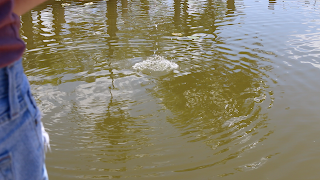I've just completed my CCR and although I'm extremely relieved, I'm sad to see this process come to an end. You can watch my reflection here. I also attached the transcript below if its needed.
Hi! Michaela Hogan here. I’m the director , writer, and editor of Dread in Turpitude and I’m going to be going over the production process of it. I'm gonna first start off with why i chose such a controversial topic and that's because in our society there's a very distinct “rape culture” which means that our culture is one that normalizes sexual abuse or harassment. Yet, there is also a unspoken but very pronounced pedophilia culture that exists, meaning that we as a whole normalize pedophilic tendencies. This pedophilia culture that we harbor is driven by the way we treat women and the way we expect them to be. If we expect women to shave their legs, be shorter than men, and act inferior then we are basically expecting them to resemble children. Women are supposed to always show youth and lack wrinkles or any sign of aging. This eroticization of the prepubescent attributes of women is so instilled in our society that it is never questioned or seemingly abnormal, yet we completely shame pedophiles for essentially being attracted to the same thing. No one wants to admit that this culture exists because it shows a weakness, a sort of hypocrisy in their beliefs. Which brings me to my next point of how I represented this shamed minority. I refrained from depicted pedophiles in the way that they always are, usually in horror movies, because i wanted to stay as far away from the stereotyping as possible, it's not helping anyone. If there's anything media can do it's that it can form beliefs in its audience, and if an audience sees a certain group only depicted in horror movies then more likely than not they're going to affiliate that group with horror. This is mainly why I used myself, a teenage girl, to be the protagonist. Women in film are also barely shown not being feminine, so me having short hair and dressing androgynously also adds to the representation aspect that I wish to achieve. I believe that my opening as a whole includes some concepts that will be hard for an audience to wrap their heads around, but it will overall be very engaging because it involves a social group that is largely overlooked in the film industry. The target audience would be most likely 20-40 year olds because it contains too much social commentary for high schoolers or younger people to be actively engaged in its storyline. Also, it is mainly targeted at women because the stereotypical man enjoys action over drama. I have also taken into account having Magnolia Pictures as a producer because they would be my main source of distribution to an audience. They primarily distribute arthouse and foreign movies that would otherwise be risky for traditional producers and they have their own DVD distribution and theater chain for independent films, Landmark theatres, which could increase the size of the target audience because it would essentially be reaching a wider pool of people. I would also make use of social media, advertising for this movie on Twitter, Facebook, Snapchat, Instagram, and on its own website so that it could also attract younger people. The platforms I would release the film on would first be cinema, probably playing in independent and local theaters, and after it would be released on different online streaming services such as Amazon Video, Netflix, and Hulu. Spotify could even have the film’s soundtrack on it. The reason it wouldn’t be distributed on a DVD is because it wouldn’t be that popular to sell, seeing as though the target audience is very specific and has to be people with a complete open mind, willing to have sympathy for pedophiles. In the production of my opening, my skills with editing deeply matured. I was able to complete the editing, color correction, and audio in less than a week, which was a great milestone for me. I integrated a wide range of technology throughout the whole process as well. I used a Canon DSLR camera to record, Premiere Pro software to edit, IMac computer to edit on, and my iphone to record the narration. Bringing all these products together to create one 2 minute film segment truly highlights the idea of convergence and the efficiency that it creates. This project was probably one of the most intense and thorough assignments i've ever done and I'm happy that i did it because i learned so much about what the film industry expects from a person, and how it's really a lot to keep up with. I'm happy with the final product that i created and i'm happy that i can finally conclude this blog. Thank you!

















































